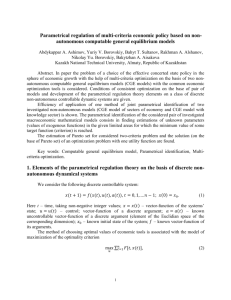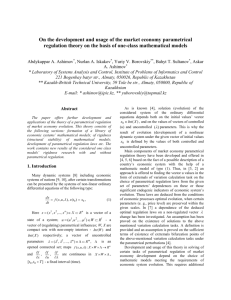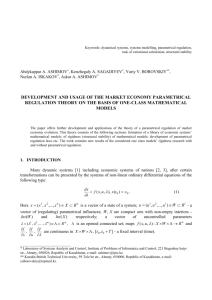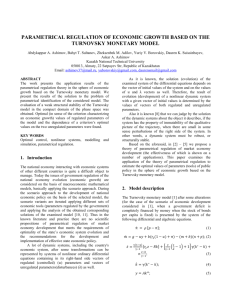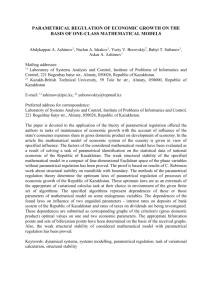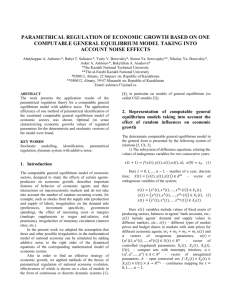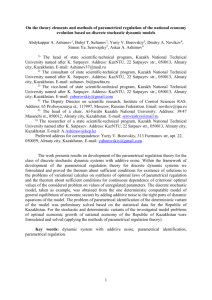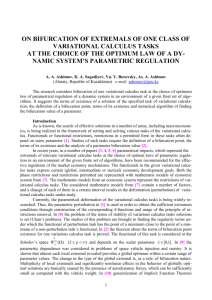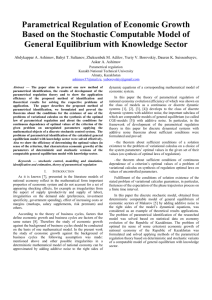355.50Kb - G
advertisement
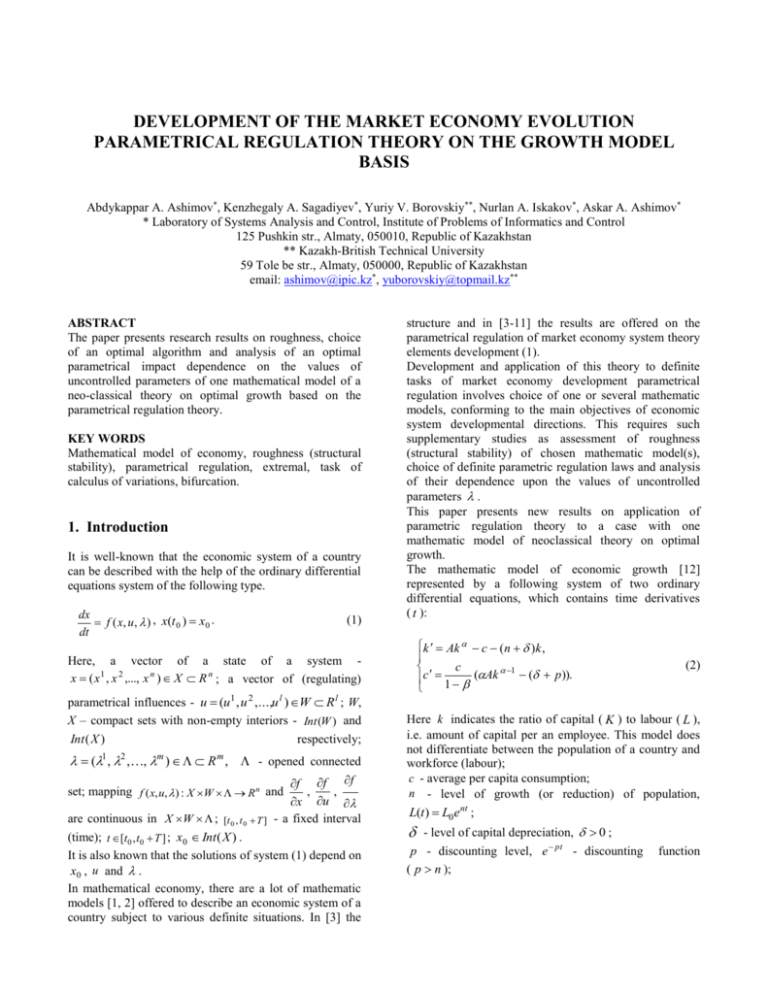
DEVELOPMENT OF THE MARKET ECONOMY EVOLUTION
PARAMETRICAL REGULATION THEORY ON THE GROWTH MODEL
BASIS
Abdykappar A. Ashimov*, Kenzhegaly A. Sagadiyev*, Yuriy V. Borovskiy**, Nurlan A. Iskakov*, Askar A. Ashimov*
* Laboratory of Systems Analysis and Control, Institute of Problems of Informatics and Control
125 Pushkin str., Almaty, 050010, Republic of Kazakhstan
** Kazakh-British Technical University
59 Tole be str., Almaty, 050000, Republic of Kazakhstan
email: ashimov@ipic.kz*, yuborovskiy@topmail.kz**
ABSTRACT
The paper presents research results on roughness, choice
of an optimal algorithm and analysis of an optimal
parametrical impact dependence on the values of
uncontrolled parameters of one mathematical model of a
neo-classical theory on optimal growth based on the
parametrical regulation theory.
KEY WORDS
Mathematical model of economy, roughness (structural
stability), parametrical regulation, extremal, task of
calculus of variations, bifurcation.
1. Introduction
It is well-known that the economic system of a country
can be described with the help of the ordinary differential
equations system of the following type.
dx
f ( x, u, ) , x(t 0 ) x0 .
dt
(1)
structure and in [3-11] the results are offered on the
parametrical regulation of market economy system theory
elements development (1).
Development and application of this theory to definite
tasks of market economy development parametrical
regulation involves choice of one or several mathematic
models, conforming to the main objectives of economic
system developmental directions. This requires such
supplementary studies as assessment of roughness
(structural stability) of chosen mathematic model(s),
choice of definite parametric regulation laws and analysis
of their dependence upon the values of uncontrolled
parameters .
This paper presents new results on application of
parametric regulation theory to a case with one
mathematic model of neoclassical theory on optimal
growth.
The mathematic model of economic growth [12]
represented by a following system of two ordinary
differential equations, which contains time derivatives
( t ):
k Ak c (n )k ,
c
1
( p )).
c 1 (Ak
Here, a vector of a state of a system x ( x1 , x 2 ,..., x n ) X R n ; a vector of (regulating)
parametrical influences - u (u1 , u 2 ,...,u l ) W R l ; W,
Х – compact sets with non-empty interiors - Int (W ) and
Int ( X )
respectively;
( , ,, ) R , - opened connected
1
2
m
m
f f f
,
,
x u
- a fixed interval
set; mapping f ( x, u, ) : X W R n and
are continuous in X W ; [t 0 , t 0 T ]
(time); t [t0 , t0 T ] ; x0 Int ( X ) .
It is also known that the solutions of system (1) depend on
x0 , u and .
In mathematical economy, there are a lot of mathematic
models [1, 2] offered to describe an economic system of a
country subject to various definite situations. In [3] the
(2)
Here k indicates the ratio of capital ( K ) to labour ( L ),
i.e. amount of capital per an employee. This model does
not differentiate between the population of a country and
workforce (labour);
c - average per capita consumption;
n - level of growth (or reduction) of population,
L(t ) L0e nt ;
- level of capital depreciation, 0 ;
p - discounting level, e pt - discounting
( p n );
function
A and - parameters of a production function
type y (k ) Ak , where y is the ratio of GDP to
labour, i.e. average labour efficiency ( 0 1, A 0 );
is a parameter of social usefulness function which
characterizes average population welfare: U (c) Bc
( 0 1, B 0 ).
The first equation of system (2) is Solou’s functional
equation of economic growth theory. The second equation
of this system is obtained from the functional’s
U (c) L(t )e
0
pt
dt BL0 e c( p n )t dt maximum, which
0
characterizes total welfare of the whole population at the
time interval 0 t . This functional is maximized
under the limits of k (0) k 0 , k Ak c (n )k ,
0 c(t ) (k (t )) and constant values of parameters ,
n , p , A , B , and .
The solution to system (2) will be considered in some
closed field , with a boundary – a simple closed curve,
which belongs to the first quadrant of the phase plane
R2 {k 0, c 0} . k (0) k0 , c(0) c0 , (k0 , c0 ) .
2. Analysis of roughness (structural stability)
of mathematic model neoclassical theory on
optimal growth
Let us conduct statement of roughness (structural
stability) of a model under consideration in a closed field
, basing on the definition of roughness and the theorem
on necessary and sufficient conditions of roughness [13].
Let us prove the following assumptions prior to the
statement.
Lemma 1. System (1) in field R2 has a single singular
point
1
k * A 1 ,
n r
*
* ( n )(1 ) p n
.
c k
(3)
This point is a saddle point of the system (2).
Proof. Having equaled the right parts of system (2)
equations to zeros, we will get the equalities (3). It is
obvious that k 0, c 0 . Let us fix down the
characteristic Jaсobi’s matrix equation for the right parts
of the equations (2) in point ( k , c ): 2 0 .
Here
and
pn 0
1
( p )(( n )(1 ) p n) 0 . Numbers
(1 )
1
2 4
0,
2
2 4
0
are
2
2
roots of the characteristic equation. Consequently, the
found particular point ( k , c ) is a saddle one for all the
given values of parameters A, , , p, n, .
Lemma 2. System (2) in field R2 has no cyclical
trajectories.
Proof. Let us assume that there is a cyclical trajectory in
field R2 . Then inside it there should exist at least one
singular point and a sum of Poincare’s indexes of singular
points located inside this cycle equals to 1 [13, p. 117].
But according to lemma 1, in field R2 there is only one
saddle point with the index -1. This is a contradiction.
Lemma 3. Stable and unstable saddle point separatrixes
(3) do not form a trajectory in field R2 .
Proof. Let us assume that the stable and unstable
separatrixes of saddle point ( k , c ) make one singular
trajectory laying in R2 . Then, this trajectory (or, if it is
available, the second trajectory composed of other stable
and unstable separatrixes) together with the particular
point are a border of a limited cell 1 in field R2 . Let us
consider the semi-trajectory L coming from some point
( k1, c1 ), where (k1, c1 ) is an internal point 1 . Then, due
to the absence of cyclic trajectories and a uniqueness of
equilibrium state, the accumulation points of L can be
only the cell boundary 1 (point (k1, c1 ) can not be the
only accumulation point L , as it is a saddle point) [13, p.
49]. Let us now consider the semi-trajectory L , coming
from point (k1, c1 ) in an opposite direction to L . It is
obvious that the boundary 1 cannot be accumulation
points of L . Due to the absence of other singular points
and trajectories in field 1 , we get the contradiction. The
lemma has been proved.
According to [13, p. 146, theorem 12] the following
theorem comes out of lemmas 1-3.
Theorem 1. System (1) is rough in closed field
( R2 ), which contains inside point ( k , c ) under
any fixed values of parameters n, L0 , , p, A, , B,
from the corresponding fields of their tasks.
The fact of absence of bifurcations of a phase-plane
portrait of system (2) in field under the change of the
parameters mentioned in the theorem in their assignments
fields follows from this theorem.
3. The task of choice of effective parametrical
regulation law
Let us now consider an opportunity of an effective state
policy realisation through the choice of optimal regulation
laws taking an economic parameter – level of capital
depreciation ( ) as a sample.
The choice of optimal parametrical regulation laws is
realized in the medium of the following dependences set:
k (t )
*,
k (0)
k (t )
2)U 2 (t ) 2
*,
k ( 0)
c(t )
3)U 3 (t ) 3
*,
c(0)
c(t )
4)U 4 (t ) 4
*,
c(0)
1)U 1 (t ) 1
(4)
Here Ui is an i law of regulating parameter ( i 1,4 );
i –is an adjustable factor of the i regulation law, i 0 ;
* – a constant equal to the base value of parameter
k (t ) k i (t ) k (0), c(t ) ci (t ) c(0);
B 1 , 0.2 , p 0.1 , n 0.05 , k0 4 , c0 0.8 ,
T 3 , L0 1 .
The results of the numerical solution of a problem of a
choosing optimum law of parametrical regulation at a
level of one of economic parameters for economic system
of the state show, that the best result K 1,95569 can be
received with using of the following regulation low
k (t )
0.19
0.2 .
4
Let's notice, that the value of the criterion without usage
the parametrical regulation equals to K 1.901038 .
It is possible, using the methods laid out in item 2, to
check up, that system (2) is also structurally stable under
the usage of the found regulation law.
;
( ki (t ) , ci (t ) ) is a solution of system (2) with initial
conditions ki (0) k 0 , ci (0) c0 under the usage of
regulation law
The task under consideration was solved under the
following values of parameters 0.5 , 0.5 , A 1 ,
U i . Usage of regulation law U i is a
substitution of a function from the right parts (4) to
system (1) instead of parameter ;
t [0, T ] , t 0 is the time of regulation start.
The task of choice of optimal parametrical regulation law
on the level of one of economic parameters can be
formulated as follows: to find on the basis of mathematic
model (2) an optimal parametrical regulation law on the
level of economic parameter in the medium of the set
of algorithms (4), i.e., to find an optimal law out of
multitude { U i }, which would provide the maximum of
4. A sample of finding the bifurcation points
of extremals for one calculus of variations
task based on a mathematic model of an
economic system
Let us consider the dependence of the results of
parametrical regulation laws’ choice on the values of
uncontrolled parameters (n, p) , whose values belong to
certain field (a rectangular) in the plane. In other
words, we will find possible bifurcation points for the
variation task (2, 4, 5 and 6) on the choice of optimal law
on a parametrical regulation of the considered economic
growth model.
criterion
T
K BL0 e ci (t ) ( p n)t dt max
0
{U i , i }
(5)
under the limits
ki (t ) k (t ) 0,09k (t ) , (k i (t ), ci (t )) , t [0, T ] . (6)
Here (k (t ), c(t )) is a solution of system (1) without
parametrical regulation.
The formulated task is solved in two stages:
- at the first stage optimal values of factors i for each
law U i are defined by way of their values sorting in
relevant intervals (quantized with small step), which
provide maximum K under the limits (6);
- at the second stage an optimal law on a parametrical
regulation of a parameter based on the first stage
results for the maximum value of criterion K will be
chosen.
Fig.1. Graphs of optimal values of a criterion.
As a result of calculation experiment there were obtained
graphs on dependences of the value of an optimal
criterion K on the values of parameters (n, p) for each
out of the 4 possible laws U i . Figure 1 presents the given
graphs for the rules U 1 and U 4 , which give the biggest
value of a criterion in area , the intersection of
corresponding surfaces and the projection of this
intersection upon the plane of values , consisting of the
bifurcation points of this parameter. This projection
divides the rectangle into two parts, where the
controlling rule U 1 is optimal for one part, and U 4 is
optimal for the other; at the projection itself both rules are
optimal.
5. Conclusions
1. Efficient usage of parametrical regulation theory has
been demonstrated on the sample of one mathematic
model of a neoclassical optimal growth theory.
2. An optimal parametrical regulation law of an economic
system development based on the considered mathematic
model has been offered.
3. Bifurcation line for the given field of uncontrolled
parameters values has been drawn up.
4. The research findings could be applied to the choice
and realization of an effective state policy.
References
[1] A.A. Petrov, I.G. Pospelov, A.A. Shanain, Experience
of mathematical modeling of economy (Moscow:
Energatomizdat, 1996), (in Russian).
[2] V.A. Kolemayev, Mathematical Economics (Moscow,
Unity, 2002).
[3] A.A. Ashimov, K.A. Sagadiev, Yu.V. Borovsky, N.A.
Iskakov, As.A. Ashimov, Elements of the Market
Development Parametrical Regulation Theory, Proc. of
the Ninth IASTED International Conference on Control
and Applications, Montreal, Quebec, Canada, 2007, 296301.
[4] A.A. Ashimov, K.A. Sagadiev, Yu.V. Borovsky, N.A.
Iskakov, As.A. Ashimov, On bifurcation of extremals of
one class of variational calculus tasks at the choice of the
optimum law of a dynamic system’s parametric
regulation. Proc. of Eighteenth International Conference
on Systems Engineering, Coventry, UK, 1996, 15-19.
[5] A.A. Ashimov, Yu.V. Borovsky, O.P. Volobuyeva,
As.A. Ashimov, On the choice of effective laws of
parametrical regulation of market economy mechanisms,
Automatics and telemechanics, 3, 2005, 105-112, (in
Russian).
[6] A. Ashimov, Yu. Borovskiy, As. Ashimov,
Parametrical
Regulation
of
Market
Economy
Mechanisms, Proc. 18th International Conference on
Systems Engineering ICSEng. Las Vegas, Nevada, USA,
2005, 189-193.
[7] Zh. Kulekeev, A. Ashimov, Yu. Borovskiy, O.
Volobueva, Methods of the parametrical regulation of
market economy mechanisms. Proc. 15th International
Conference on Systems Science, Vol. 3, Wroclaw, Poland,
2004, 439-446.
[8] A. Ashimov, Yu. Borovskiy, As. Ashimov,
Parametrical Regulation Methods of the Market Economy
Mechanisms, Systems Science,33(1), 2005, 89-103.
[9] A.A. Ashimov, K.A. Sagadiev, Yu.V. Borovsky, N.A.
Iskakov, As.A. Ashimov, Parametrical regulation of
nonlinear dynamic systems development, Proc. 26th
IASTED International Conference on Modelling,
Identification and Control, Innsbruck, Austria, 2007, 212217.
[10] A.A. Ashimov, K.A. Sagadiev, Yu.V. Borovsky,
N.A. Iskakov, As.A. Ashimov, On the market economy
development parametrical regulation theory, Proc. 16th
International Conference on Systems Science, Wroclaw,
Poland, 2007, 493-502.
[11] A.A. Ashimov, K.A. Sagadiev, Yu.V. Borovsky,
N.A. Iskakov, As.A. Ashimov, Parametrical regulation of
nonlinear dynamic economic systems development, Proc.
2nd International conference on “Mathematic modelling
of social and economical dynamics” (ММSED-2007),
Moscow, Russia, 2007, 23-25, (in Russian).
[12] L.P. Yanovsky, Chaos controlling in the models of
economic growth, Economics and Mathematical Methods,
38(1), 2002, 16-23, (in Russian).
[13] N.N. Bautin, Ye.А. Leontovich, Methods and ways
of quality analysis of dynamic systems in the plane
(Moscow, Nauka, 1990), (in Russian).
